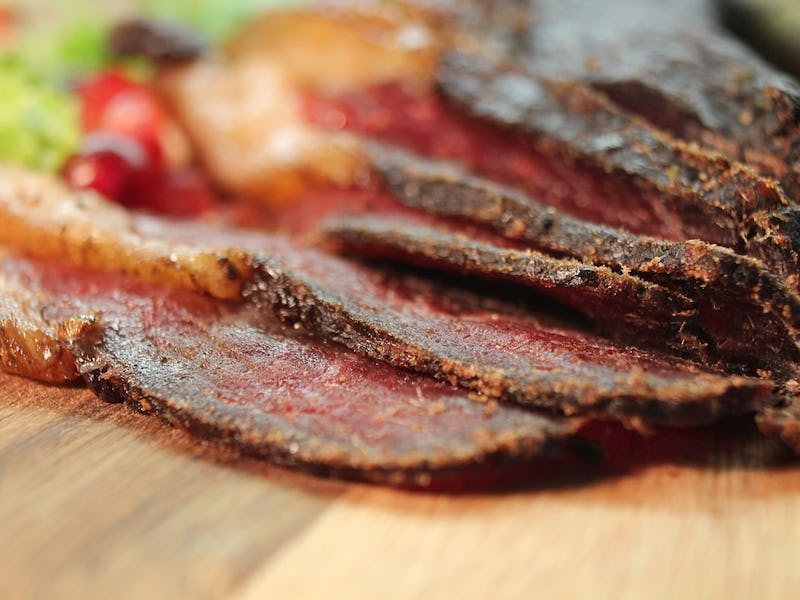A Scientist Clarifies the Link Between Eating Beef Jerky and Mania
Fans of cured meat, take note.

Eating lots of hot dogs and beef jerky is perhaps not the wisest choice for physical health, but until recently, doing so seemed fine as far as mental health was concerned. But a new paper, released Wednesday in Molecular Psychiatry, has raised concerns about the connection between eating nitrated dry-cured meats and mania. One author of the study, Johns Hopkins pediatrics professor Dr. Robert Yolken, is here to set the record straight.
In the study, Yolken and his colleagues conducted a ten-year analysis of health and nutrition data on 1,101 people with and without psychiatric disorders, including mania, bipolar depression, major depression, and schizophrenia. The analysis showed that a history of eating nitrated dry-cured meat is linked to an increased likelihood of being hospitalized for mania — a complex and poorly understood characteristic feature of bipolar disorder. The link only applied to people hospitalized for manic episodes in particular — not bipolar disorder in general — and no causal relationship has been established. The researchers hypothesize that the underlying cause of the connection is the the consumption of nitrites and nitrates.
But Yolken and his team won’t speculate on any specific impacts of dietary interventions yet or comment on whether individuals without mania should quit it with the jerky.
“We really don’t want to make any suggestions as far as diet for individuals who don’t have psychiatric disorders,” Yolken tells Inverse. “All we’re really suggesting, based on our study, is that people with mania may want to discuss with their medical caregiver or dietary consultants the possibility of looking at the amount of nitrates in their diet.”
Meat sticks like Slim Jims are linked to hospitalization for mania in new study.
Nitrates are chemical compounds found naturally in vegetables like garlic and onions but are also produced synthetically. They’re most often added to processed foods as a preservative; in processed and cured meats, they help muscle tissue retain their appetizing shade of reddish-pink. The curing salts that are used to make salted, preserved meats are typically a mixture of table salt and a similar inorganic compound called sodium nitrite, but sometimes this mixture contains sodium nitrate as well.
Yolken says the team was surprised to find a connection between eating nitrated cured meat and mania within their sample, so they studied the impact of the chemical compound on rats to investigate further. One group of rats received normal food, and the other received the same meal plus a bit of store-bought, nitrate-prepared beef jerky. The amount of jerky they consumed was proportional to one serving for a human.
Within two weeks, the jerky-eating rats began to show signs of hyperactivity and insomnia — symptoms that often accompany manic episodes. But when the rats were given nitrate-free jerky, that behavior didn’t occur, strongly suggesting that the behavioral changes were linked to the chemical compound’s interaction with meat.
Dissecting the rats showed changes in their gut microbiome, which is in line with the findings of recent studies showing that gut bacteria may contribute to mania and other disorders that affect the brain.
“We think that what’s going on with psychiatric disorders, particularly mania, is that individuals are more susceptible to some environmental factors, perhaps on a genetic basis,” says Yolken. That’s why he thinks that the nitrates in meat aren’t going to affect people who don’t have the predispositions affiliated with mania.
Rats given nitrated cured beef jerky displayed signs of hyperactivity and irregular sleeping patterns.
Many complex disorders — not just psychiatric ones — are influenced by our genes and our environment, says Yolken. What we eat counts as the latter. Previous studies have shown that when people with bipolar disorder are given probiotics after a manic episode, both the composition of their gut bacteria changes and they are less likely to be re-hospitalized.
Because the rats that ate nitrated meats had unique patterns of gut bacteria, it seems probable that nitrated cured meats may count as one of these influential environmental factors. As this connection continues to be studied, the team writes, “these findings may lead to new methods for preventing mania and for developing novel therapeutic interventions.”
It’s early days for research into the connection between cured meats and mental health, and this study just skimmed the surface. For one thing, the survey data used were all self-reported, and they didn’t take into account the frequency or time frame of cured meat consumption. For now, the team can only report that a link between cured meat consumption and mania hospitalization exists, but they can’t say whether eating a particular amount — or eating for an extended period of time — is any more or less consequential.
Cured meat fans, take note: This study specifically applies to meats cured with nitrates or nitrites, like jerky and meat sticks — and not meat that’s been cured naturally, like salami or prosciutto.